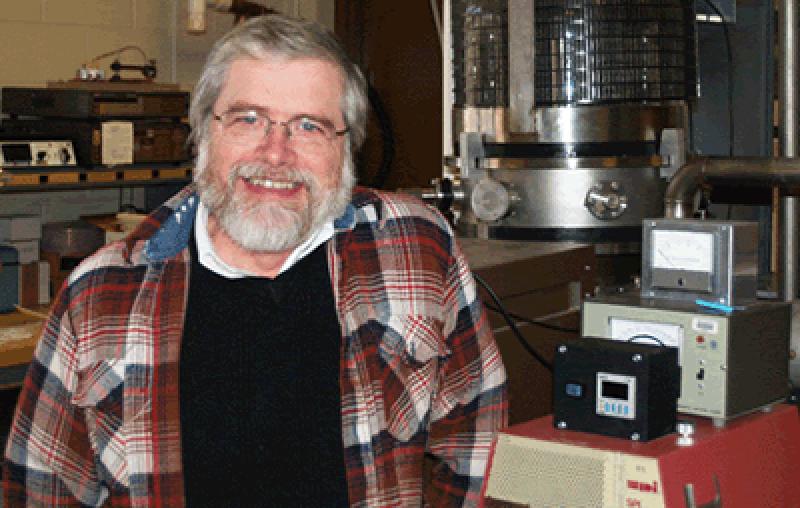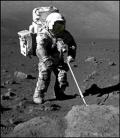The Win-Win
Spring
2014
Special Feature
Staying Connected
The Win-Win
Connecting undergrads to research in your laboratory
By:Jim Gaier, Research Physicist, NASA Glenn Research Center, Cleveland, OH

I came to the Society of Physics Students and Sigma Pi Sigma late in life. I was, after all, a chemistry major in college. But I also took lots of physics courses as an undergraduate (just one short of a major, really), and my work as a chemist has refused to stay neatly within traditional disciplines. My graduate studies in x-ray crystallography solidly straddled the line between chemistry and physics. To make matters worse, my research focused on determining the structures of biological molecules. After graduate school, NASA hired me as a research physicist to do chemical synthesis and characterization of intercalated graphite fibers. I then joined the chemistry faculty of Manchester College (now Manchester University) in North Manchester, Indiana. One spring soon after, I was invited to join Sigma Pi Sigma. This is when I started my relationship with SPS—late in life, as I mentioned earlier.
After accepting the position at Manchester, I continued to straddle lines by recruiting students from both the chemistry and physics departments to work with me on my research. One of the disadvantages of being a student at a small school such as Manchester is that opportunities and resources to try out research, particularly with expensive, state-of-the-art equipment, are often limited. One of the disadvantages of being a professional scientist at NASA is that we are often constrained by the availability of personnel, so utilizing students to help with NASA research seemed to be the perfect win-win. Indeed, it has been.
Nearly 10 years ago, when I left the faculty at Manchester and returned full time to NASA, I saw no reason why my relationships with students and faculty members at Manchester, the best part of my experiences at the university, should have to end. So I and Greg Clark, the Manchester physics department chair, remain in weekly contact, keeping each other appraised of opportunities at both institutions to collaborate. There have been many.
For example, last year students and SPS members Alyssa Loos and Dylan Ford took advantage of Manchester University’s January term, a month-long break from students’ usual coursework, to do research in my lab for course credit. Alyssa set up a new Fourier transform infrared spectrophotometer (FT-IR), and then studied the degradation of white ortho-fabric samples that had covered large battery packs mounted on the International Space Station for nine years. She used not only the new FT-IR, but also a field emission scanning electron microscope (FESEM) equipped with an energy-dispersive x-ray spectrometer (EDS). This work paved the way for NASA and industry partner ILC Dover, based in Frederica, Maryland, to understand the space environment degradation mechanisms for spacesuit fabrics, which will inform the design of the next generation of spacesuits.
Dylan put together an apparatus to measure the diameter of tiny carbon nanotube yarns in situ while they were being tensile tested using a single-slit-like diffraction technique. This was required because, like any yarn, the material weave tightens up as it is pulled, so to determine the intrinsic ultimate tensile strength, the cross-sectional area must be well determined.
“Many of the ideas students bring are obviously crazy and may even violate physical laws, but they also may spark a new insight, or even an innovation.”
Other students, such as Kerry Rogers and Greg Robison, applied to and were accepted for NASA summer internship programs. Paid for their efforts, they leveraged their NASA work by using equipment at both NASA and Manchester. Kerry wrote a software algorithm to statistically sample microscopic locations on spacesuit fabrics in order to determine the amount of simulated lunar dust left on them after exposure and cleaning. He then looked for damage on other scales using not only NASA’s FESEM/EDS, but also Manchester’s atomic force microscope. Greg designed and built an apparatus to measure the electrical and thermal conductivity of carbon fiber epoxy composites in vacuo at NASA, and then characterized their gamma ray shielding ability at Manchester.
Stephen Berkebile worked both at NASA and Manchester, where he designed and built an instrument to map the two-dimensional electrical conductivity of symmetric and asymmetric woven carbon fiber composites. After graduate school, Stephen returned to NASA as a postdoctoral fellow. He measured the tendency of a synthetic volcanic glass that mimics the major component of lunar dust to adhere to metals and plastics found on spacecraft. He also completed a detailed design of a cosmic ray telescope to be used to characterize the effectiveness of new cosmic ray shielding materials for spacecraft. Whether effective cosmic ray shielding materials can be developed may ultimately determine whether human journeys to Mars and the outer planets are feasible.
I believe that research internships, preferably outside of an academic setting, are critical to the development of young scientists. I recall one of my first Manchester interns, after one of those intensely frustrating days that are so common in research, looking up at me and saying, “You really don’t know the answer, do you?” She had been so accustomed in school to wrestling for an answer that the instructor already knew that she had missed the point of science—to develop new knowledge. This was a revelation that completely changed her view of science, and her role in it.
Students also revitalize a workplace’s vitality, which can wane when the same team works on the same projects or slowly evolving projects. Our group at NASA brings in many interns during the summer; some years they nearly double our size. As they arrive you can feel the enthusiasm level rise. This is our most productive time of the year, not only because we have extra hands, but because we have extra minds with new ideas. Many of the ideas students bring are obviously crazy and may even violate physical laws, but they also may spark a new insight, or even an innovation.
In addition to hosting these and many other Manchester students over the past 20 years, I have also been invited back to Manchester to give several seminars to the science students, to deliver a convocation to the entire student body, and, twice, to be the keynote speaker at the year-end SPS banquet. Many of us in our work seldom get out and talk to nonspecialists about what exactly we do and why we do it. Framing our work such that its value can be glimpsed by college freshmen adds perspective, and getting an enthusiastic response affirms that our work is important. I believe that my ongoing involvement with the students and faculty of Manchester University has deepened and enriched their connections to the world of science. I know that our work together has deepened and enriched my life.



